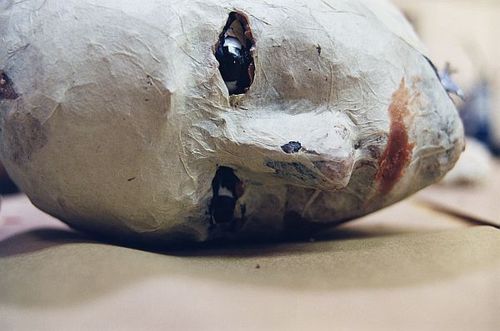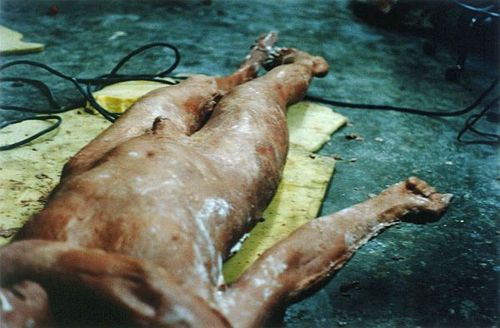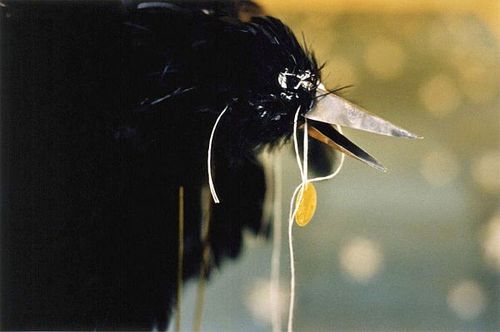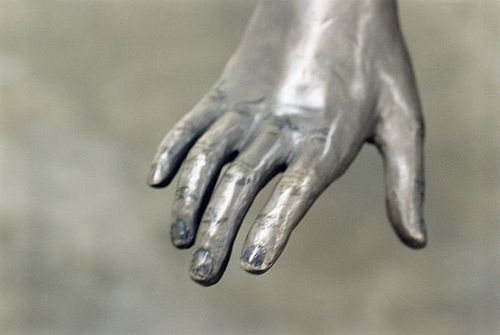To her friend Robin Winters, Kiki Smith said:
I don’t think my work is particularly about art. It’s really about me, being here in this life, in this skin. I’m cannibalizing my own experience, my surroundings.
Clearly this is true, but after looking at her work for 30 years, what do I know about her? Nothing personal. I know she appreciates animals both real and mythic, and that she thinks of fairy tales as a mother lode from which she extracts a mutable range of meanings.
 In the 1970s, feminism was for her decisive. Through its lens she became an
In the 1970s, feminism was for her decisive. Through its lens she became an
artist. Whatever it is that the official art world
rejected, she embraced: small works on paper, coy/lurid/loose subject
matter, unreliable structures, the homemade and the handy: what she
could put together on her kitchen table.
Like a mole burrowing into a hole, she digs into the specific experience of women and animals in the world. (When a male makes an appearance, he is frequently a corpse.)
 She’s interested in paws and feet; in heads, bellies, hands and claws;
She’s interested in paws and feet; in heads, bellies, hands and claws;
in tongues, eyes, blood and drool; in breasts and genitals, in skin
(both furry and bare); in ribs, breath and gesture: in lives lived under the
starry skies. Her idea of personal is treating herself as part of this image stream. When she appears in her work, it is as archetype
instead of individual.
Like a magician who can saw a woman in two without benefit of a box, she disappears in full view of the audience into her flagrantly candid depictions. In her youth she portrayed herself as a banshee girl, the one game enough to be wrestling on stage at the Kitchen in with David Wojnarowicz, or, as she put it, “beating each other up.” Before hitting 50, she rushed to embrace middle age, opening as it does the possibilities of the crone and harpy.
 In his 2006 review of her mid-career retrospective at the Whitney, Holland Cotter found the essence of her gory yet exacting production:
In his 2006 review of her mid-career retrospective at the Whitney, Holland Cotter found the essence of her gory yet exacting production:
The tone is at once light and grievous; dreamlike dramas recur. There are miracles and martyrdoms, bursts of cruelty and hilarity. In a kind of boomerang karma, humans merge with animals, and animals have spiritual lives. Crystal tears pile up in corners; bones and worms are served up for meals.
Fanciful as it is, Ms. Smith’s art is also deeply, corporeally realistic. Step off the elevator on the Whitney’s third floor, and you’re in a wonderland version of a pathology lab. Empty glass jars carry the names of bodily fluids they are meant to hold: urine, sweat, saliva, mucus, milk, semen. A rib cage hangs on the wall near sets of internal organs. What looks like a flayed skin sits folded on a pedestal.
Each item has a freakish beauty. The ribs, cast in pale terracotta and held together by string, suggest chimes. The organs — male and female urogenital systems — are of a prettily patinated bronze. The folded skin looks plush and warm; it is made from panels of sheep’s wool stitched together with human hairs. (more)
Her approach to materials is inclusive, with no distinction between major and minor media, and yet, considering that she is best known as a sculptor, photography is a constant. Because it has always been there, at first incidentally and later with purpose, Elizabeth Brown’s exhibit at the Henry Gallery stands as a core inside the artist’s core: I Myself Have Seen It: Photography & Kiki Smith.
 More is more: Many hundred postcard-size photos line the baseboards of the galleries. There are just enough sculptures to hold the show together, in glass, ceramic and bronze. Amid the photos are prints, some large-scale. Small black harpies perch above doors and on moldings, easy to miss but essential once seen, drawing the eye upward to engage the space, ceiling to floor.
More is more: Many hundred postcard-size photos line the baseboards of the galleries. There are just enough sculptures to hold the show together, in glass, ceramic and bronze. Amid the photos are prints, some large-scale. Small black harpies perch above doors and on moldings, easy to miss but essential once seen, drawing the eye upward to engage the space, ceiling to floor.
Smith likes to shoot at the edges of things, in her studio or at a foundry, in friends’ homes (never identifiable), in her yard. Her sculptures are just one element amid the smear of everything else: the worms on newspaper, the cat on its back, the hand of a sculpture, blue dusting its fingers.
In Brancusi’s photos of his work in his studio, he located the sculptures in a space they dominated. Smith uses photography to present her work as part of the wider world – an inflection instead of a narrative.
Within the fluidity of her range, however, she is the one who emerges, this woman who never lost a child’s awe and discomfort about the singular consciousness alive in her own body.
This is a show designed for repeat viewings, for skimming across the surface and for digging into particulars. I Myself Have Seen It runs through Aug. 15. It’s is a triumph for the Henry and a personal milestone for Brown, the Henry’s senior curator. Images do not by accident unfold with such inevitability, gallery to gallery.



Leave a Reply